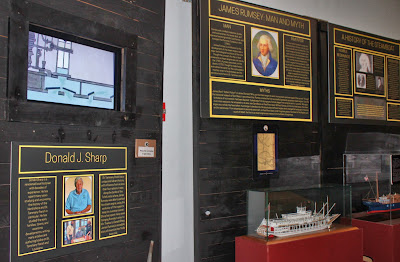Historian Donald J. Sharp recently completed an extensive interview about the history of the Lake Pontchartrain northshore with a focus on James Rumsey and his time spent in St. Tammany Parish working on his secret experiments.
Rumsey lived in New Orleans for five years, Lacombe for a few years, then moved to Pearl Island at the mouth of the Pearl River for three years. But while Don's earlier talks dealt with Rumsey's success in developing a steam-propelled watercraft, this expanded version shows his other accomplishments, among them 20 patents for his improvements to the grist mill and the waterwheel, as well as his friendships with key early American historic figures.
Rumsey's work on steamboat propulsion in Lacombe helped bring about the arrival of steamboats coming down the Mississippi River just a few decades later, thus changing the history of New Orleans.
According to multiple sources, Rumsey seemed to be a key player in the early American history. He worked as a superintendent of engineering for George Washington, was honored by Benjamin Franklin who started a society promoting Rumsey's inventions, and was friends with Thomas Jefferson while he was in Europe. Jefferson said that Rumsey was one of the most impressive geniuses he had ever met.
Rumsey came to the American colonies from England as a member of the British army, was sent to Illinois Territory to help deal with the Native Americans, but then left the military to become a frontier merchant. As a merchant, he brought supplies to the settlers and traded with the Native Americans in the fur trade. As Britain frowned upon American colonists heading further and further westward, Rumsey found himself on the forefront of the westward movement.
After the fur trade business collapsed, Rumsey went to Natchez, MS, and on to New Orleans, where he made friends with the heads of the city. An opportunity arose for him to buy land in Lacombe, and it was a perfect place to conduct his research.
When the American Revolution broke out, he re-located to Baltimore, where he finished work on his steam-powered watercraft and presented a successful demonstration of the boat on the Potomac River at Shepherdstown, West Virginia, a few years later.
Click on the above image to make it larger.
Here is a link to Don Sharp's latest historical presentation about James Rumsey and the history of the northshore area.
Sharp worked for decades to unveil Rumsey's true background, since many American historians had been led to believe that he was born in Maryland. Through extensive research in both history and genealogy, Sharp was able to track down Rumsey's actual birthplace as Bristol, England. His main incentive for developing the steamboat was an effort to make money to send to his bankrupt father back in England, who was a sugar broker who lost five ships and was financially strapped as a result.
Rumsey was chief engineer on an interstate waterway project being pursued by George Washington, and when the Articles of Confederation posed some obstacles in the way of completing that project, Washington and others sought a new founding document that would allow two states to cooperate with each other on projects of mutual interest. That document wound up being the U.S. Constitution.






.JPG)








